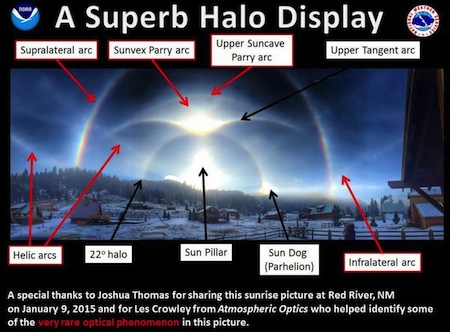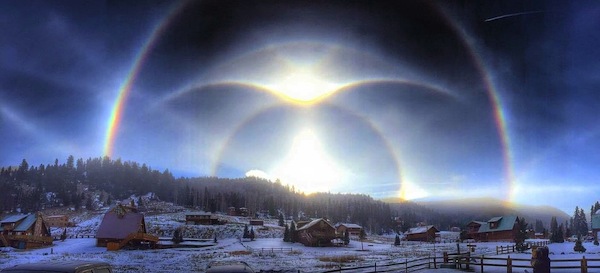Could this be an omen – a portent of good news?
Joshua Thomas recently captured this amazing photo of no less than NINE heavenly phenomena in Red River, New Mexico. It was shared on social media by the USA National Weather Service.
The Washington Post picked it up and ran an article headed “Nine optical phenomena captured in one amazing photo.”
What I find utterly astonishing about this, is that tens of thousands of people are now learning Maharishi Mahesh Yogi’s Transcendental Meditation in North America.
And tens of MILLIONS will soon be learning in South America.
Could this incredible celestial display be some kind of an omen or portent of what is about to happen on earth? I get a tingle running up and down my spine as I think about this.
Would you like to know something even more amazing? The Washington Post published this article on — guess when? — 12th of January, Maharishi’s birthday.
The photo itself was taken on January 9, 2015. Various forms of ice crystals need to be present and very specifically aligned in the atmosphere for each of these to occur according to Angela Fritz, an atmospheric scientist.
A Rare and Extraordinary Phenomenon
 Here is an annotated photo.
Here is an annotated photo.
Read what it all means from Angela’s scientific viewpoint to discover just how rare and extraordinary was this sight:
Supralateral arc: The largest halo in the image is a rare arc which varies in shape depending on how high the sun is in the sky. It forms when sunlight passes through the base of rod-shaped hexagonal ice crystals, and exits through a prism side of the crystal.
Parry arcs: also change shape depending how high the sun is. The orientation of the ice crystals needs to be just perfect for this feature to appear; the length (axis) of the column crystal must be perfectly horizontal, as well as two of the prism sides. “If the near perfect orientation of column crystals sounds improbable, that of Parry oriented crystals must seem wildly so,” writes Les Crowley on his wondrous site.
Upper tangent arc: also changes shape depending on the elevation of the sun. and appears when hexagonal rod-shaped crystals are oriented horizontally, but are free to rotate around their long axis.
Helic arcs: These arcs seem to originate from the sun itself, traveling up and away. These arcs are also formed by light passing through crystals in the same position as the Parry arcs.
The 22-degree circular halo is formed when sunlight passes from one prism side of a hexagonal crystal to another. These halos are more common than the other phenomena because the ice crystals are randomly oriented.
Sun pillar: This might appear like a large ray of sun shooting upward, but it’s actually the appearance of light passing through millions of ice crystals. According to Crowley, they are most common 30 to 60 minutes after the sun as set at ground level.
Sun dogs are also called “mock suns,” or scientifically, “parhelia,” and are often seen in conjunction with a 22-degree halo, since they are formed from the same kinds of ice crystals. However, as the plate-shaped crystals sink through the air, they can become vertically aligned instead of randomly oriented, which allows the light to pass through horizontally, creating the sun dogs. Each bright spot is a single sun dog, or parhelion.
Infralateral arc: This looks most similar to a typical rainbow, except you won’t see it when it’s rainy! It also changes shape based on the elevation of the sun, and seems to originate from the base of the supralateral arc. Infralateral arcs are formed when light passes through the base of hexagonal rod-shaped crystals, and exits through one of the sides of the crystal.
As David Lynch says on one of our DVDs, “it’s going to be a better world.”
And you read it here first!

